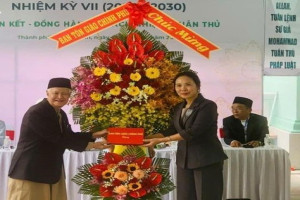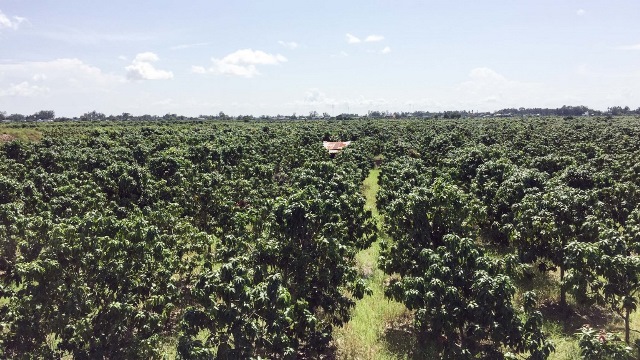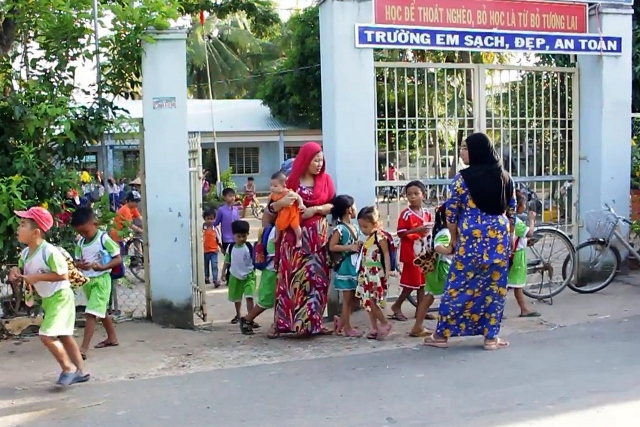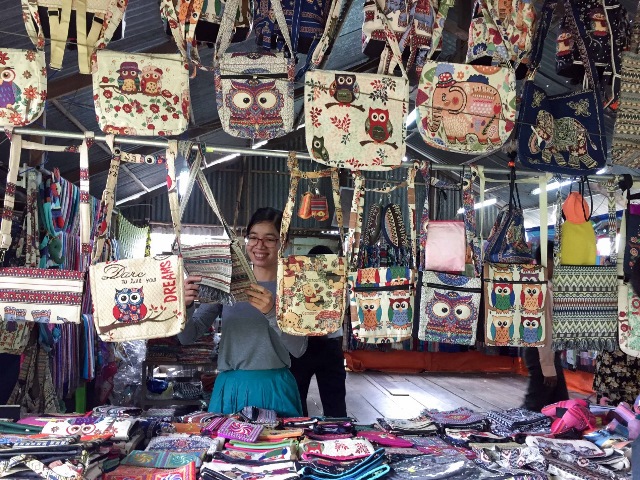
Where a branch of the Mekong River named Hau Giang River pours in Vietnam, at the northwesternmost border of the Mekong Delta, Cham border villages around Bung Binh Thien Lake have gradually transformed themselves to match with the rhythm of the modern life.
Aly, an official from the Mosque of Khanh Binh Commune (An Phu District, An Giang Province), recalled his old memories: “This old Cham village was the poorest neighbourhood in the district, very few people were educated in the past. Recently, in the New Rural Development Programme, disadvantaged Cham families have been given land to build houses and offered loans to run their business. The State also provides vocational training for locals, as well as supporting and encouraging us to do business. I have a large farm and following the encouragement of the commune officials, I converted my crops into mangoes, which have generated high yield rather than rice and corn crops in the past. Our lives are much more developed than before. Roads and bridges have been built both even in the fields to make travelling more convenient. Since then, local people have escaped from poverty and enriched themselves.”
Also recalling the old days, Mach Sa Le, a resident in An Phu’s Da Phuoc Commune, said: “After a few decades following the past wars, I see that the life of people here is ten times happier than before. It is now more and more modern and affluent. Many Cham people get rich by seizing the opportunity to do business. My family is not rich yet at the moment, but we can afford to spend on our own life and have not to suffer much like in the past.”
With the same name and the same way of thinking, another Mach Sa Le, an official from the Mosque of An Phu’s Nhon Hoi Commune cum deputy head of the An Giang Provincial Muslim Community, said: “The local life was extreme hard during past wars but now it is full of comfort.” Anyone who has experienced turmoil like Mach Sa Le could know how precious peace is.

In Khanh Binh, mangoes bring more economic benefits than traditional crops. (Photo: NDO/Lam Long Ho)
“Now the State takes care of all the children and the elderly, offering everyone a chance to learn and to have a better life. Bridges, roads, school and stations have been built. Since the presence of Programmes 134 and 135, Cham people have been secured to live here. This Cham village alone has hundreds of houses constructed under the support from the State. Hospitals and clinics have been established to take care of our health. Moreover, the Government also protects religious freedom and takes care of the Cham ethnic people’s lives. Every holiday, the local authorities pay visits and present gifts to us. They are not big ones but very precious. Seeing the benefits brought about by the policies of the Party and the State, local people here always support and join the Party and the State in building new rural areas, contributing to promoting the development of a prosperous and strong nation,” Mach Sa Le added.
According to Master Doan Binh Lam, Vice Chairman of An Phu District People's Committee, previously, the district was like an islet surrounded by Hau, Binh Di and Chau Doc Rivers, with a range of unfinished roads, making people's transportation very difficult. In 2007, Con Tien Bridge was inaugurated, opening a gate for people in the district in general and Cham people in particular to reach out to do business and connecting tourism from Chau Doc city to the locality, making it convenient for trading activities.
After ten years, in 2017, another bridge connecting An Phu with the world, the Long Binh Bridge crossing over Cambodia, was finished, creating the shortest route from Vietnam to Phnom Penh, opening opportunities for local people and businesses to get rich. Especially, Cham hamlets on Bung Binh Thien Lake have great tourism potential due to its beautiful landscape and typical indigenous culture, attracting a considerable amount of visitors.
In recent years, through the implementation of policies from both the central and local levels, Cham people’s lives have improved a lot. Passing local Cham neighbourhoods there, it is easy to find out that a new countryside is gradually shaped over the concrete houses growing quickly, with many outstanding locals enriching themselves and gaining success as doctors and engineers.
Nguyen Van Tri, Vice Chairman of Khanh Binh Commune People's Committee, said that Khanh Binh is a border commune with three hamlets bordering Cambodia and one of them is in extremely difficult conditions. The commune has nearly 200 Cham households with more than 1,000 inhabitants, characterised by limited productive and residential lands. However, with the support from the Party and the State, along with the mobilisation from the locality, most of the locals have been sustained in sustainable poverty alleviation. On the local basis, the commune has helped them access loans and offered them with vocational training and support for land and science and technology application in production and changing the structure of plants and animals that have brought about positive results. Recently, many Cham people in the area have developed trading activities. In recent years, the border Cham villages have sprouted up with spacious tile and concrete houses, changing the appearance of the countryside and contributing to the general development of the locality on the way of building a new countryside.

Cham mothers in Nhon Hoi pick up their children from schools. (Photo: NDO/Lam Long Ho)
The model of "joining together to do good things" in Cham hamlets has helped boost social security and order in the area, as well as ensuring economic development. Despite having a low starting point as a difficult commune, under the spirit of the State and the people joining hands together, including the great contribution of the Cham community, Khanh Binh is expected to realise all the New Rural Commune standards by the end of this year 2019 to be recognised as a new rural area one year earlier than its set roadmap.
Pham Tan Thoi, Vice Chairman of Da Phuoc Commune People's Committee, informed that since the new rural area construction policy has been implemented, the material and spiritual life of the Cham people in the commune has been improve. People support and actively participate in such models as removing temporary houses for their own neighbours, making enthusiastic contributions in building landscapes, lighting up rural roads, and repairing roads, as well as in many other social activities.
Arriving to Da Phuoc on holidays, it is not difficult to catch foreign tourists going along beautiful Cham villages, which are built by efforts from local Cham communities. Through the infrastructure invested by the Party and the State, together with the spirit of overcoming difficulties of locals, many production and business models have been expanded, creating jobs for a significant part of the labour force among the Cham people.

Local Cham handicraft villages attract more and more tourists. (Photo: NDO/Lam Long Ho)
The good sign is that Cham people have known how to cooperate and support each other in production to expand their businesses. There are export items that bring high economic values. The local governments also cooperate with the Cham religious dignitaries to encourage local people to preserve their customs, habits, and languages to attract tourists, which are also the activities under the goal of building an advanced culture imbued with the country's national identities.
An official from the Da Phuoc Commune’s Mosque, also named Aly, said: “Cham people here see the benefits of building their new countryside so whenever the State mobilises us to do so, whatever it is, me and my fellow neighbours all try to follow and contribute a part to the joint work. In fact, it is also beneficial to us, such as buying health insurance cards is bringing the benefits to us as the State will support our healthcare in case of sickness. Growing flowers and trees, beautifying the streets, and disposing of rubbish in the prescribed places are also activities that help our houses and neighbourhoods, so that we can attract more tourists to come and spend here to increase our incomes. The Party and the State help the society develop, so we can in turn benefit from this process. I think building a new countryside is to build our life more and more civilised and to become a more prosperous village. Where the government works, my relatives and I will join them.”




